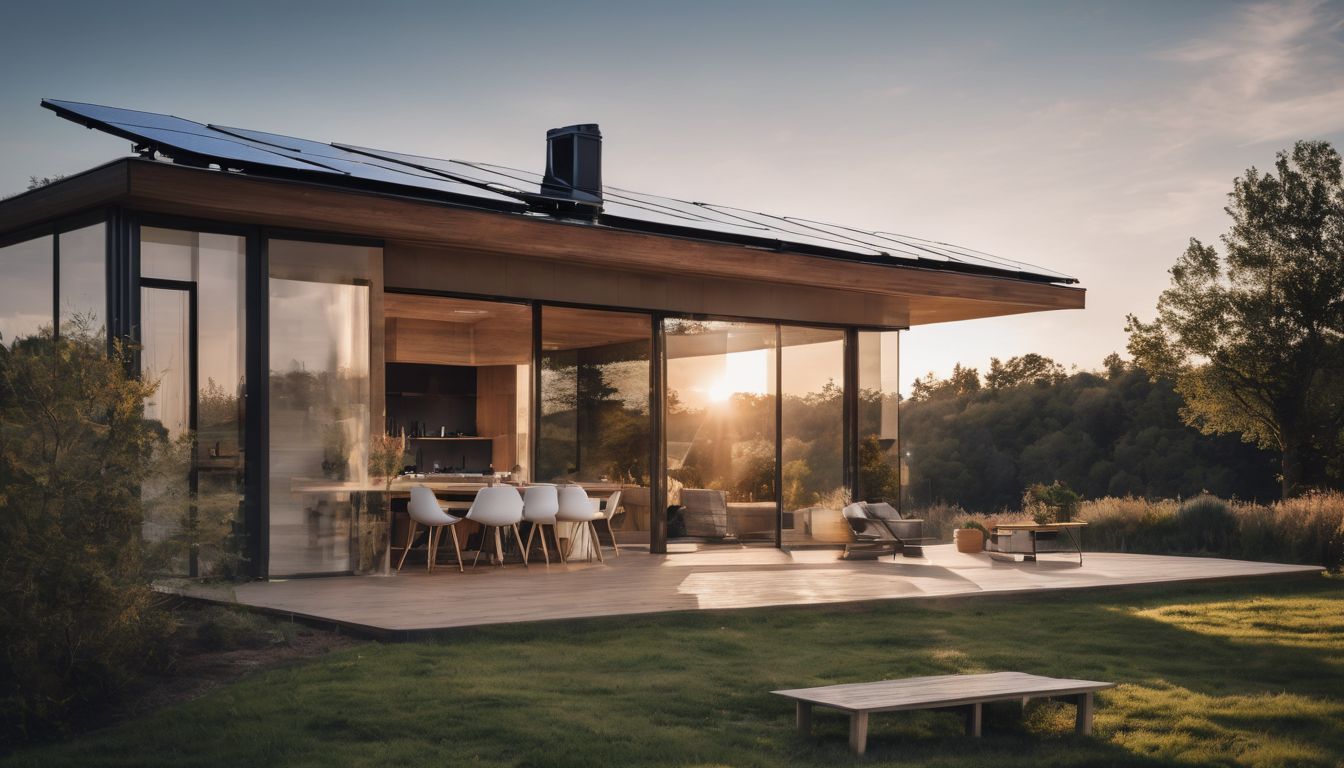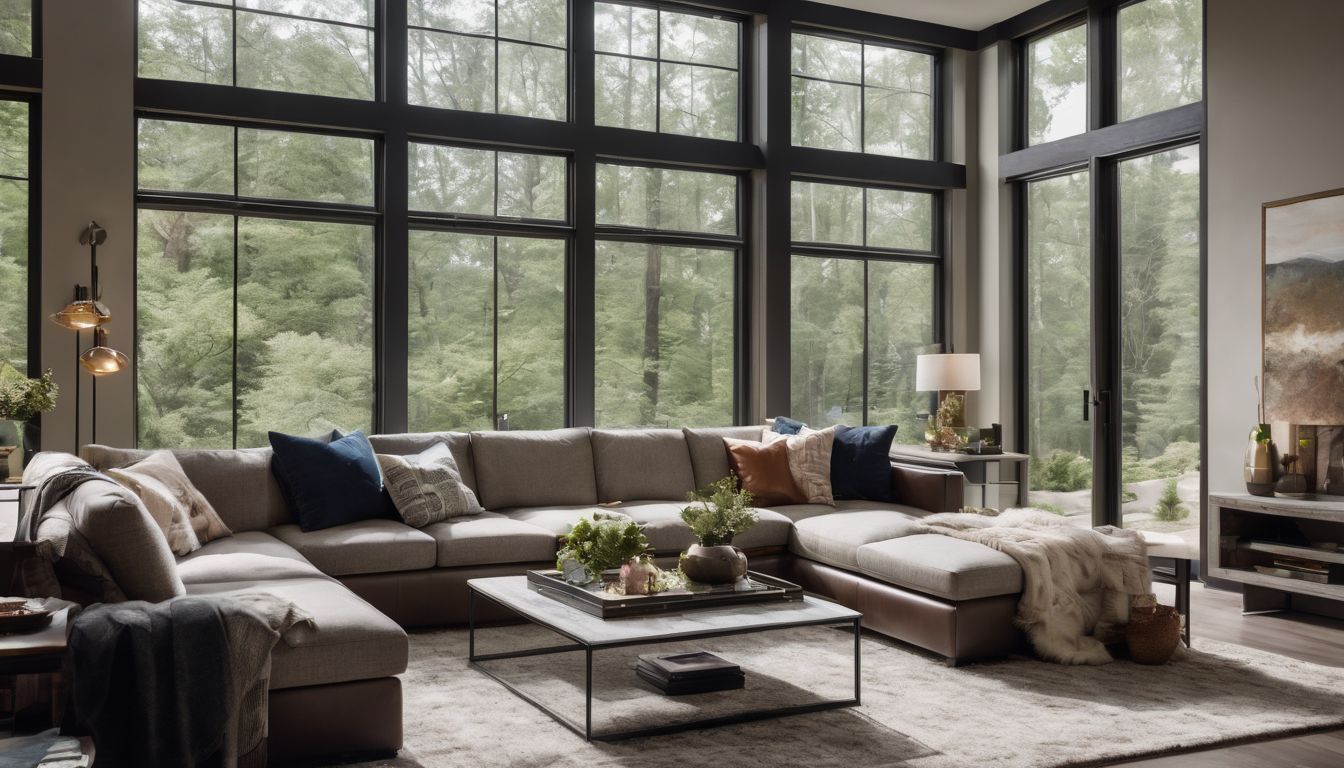Choosing the right renewable energy source for your home can feel like a tough puzzle to solve. In the UK alone, over 900,000 homes have solar installations. Our guide will help you weigh up solar and wind options, making that decision clearer and easier for you.
Let’s find out which is the winner for your home!
Key Takeaways
- Solar panels work best in areas with high sunlight exposure, can last 25-30 years, and have become more affordable due to technological advancements. The average cost for a home solar system ranges from £5,000 to £20,000 but can be offset by government schemes like Feed-in Tariffs or Smart Export Guarantees.
- Wind turbines are suitable for regions with consistent wind flow and range from £10,000 to £30,000 in installation costs; considering rebates or incentives is beneficial. Noise and visual impact as well as effects on wildlife should be considered before installation.
- Both solar and wind energy significantly reduce household carbon emissions compared to fossil fuels. While initial costs can be high for both systems, they offer long-term savings on energy bills with low operating costs after setup.
- Combining solar and wind power maximises efficiency by using sunlight during the day and capturing wind at night or during overcast conditions. This combination ensures a more reliable supply of renewable energy to your home.
- Assessing factors like location availability, space requirements for installations, local regulations on renewable energy use before making decisions between solar vs. wind is critical for an effective residential renewable energy solution.
Understanding Solar and Wind Energy
Solar energy is harnessed through the use of photovoltaic panels, which absorb sunlight and convert it into electricity. Wind energy, on the other hand, is generated by wind turbines that capture kinetic energy from the moving air and transform it into power.
Both options provide renewable sources of clean energy for homes.
What is solar energy?
Solar energy harnesses the power of the sun’s rays to generate electricity or heat. It’s a clean, renewable source that relies on solar panels, usually mounted on rooftops or in large outdoor spaces.
These panels contain photovoltaic cells that convert sunlight into direct current (DC) energy throughout the day.
This ecofriendly energy can reduce reliance on fossil fuels, decrease greenhouse gas emissions, and offer sustainable power for homes and businesses. Solar systems come in various sizes to suit different needs, making them versatile for both urban and rural settings where sunlight is abundant.
As advancements continue in technology, solar panel efficiency improves, further encouraging their use as a green power option.
What is wind energy?
Now let’s explore wind energy. Wind energy refers to the process of harnessing the power of the wind to generate electricity. It involves using turbines to capture the kinetic energy created by the movement of air, converting it into electrical power that can be used for residential and commercial purposes.
Wind energy is a renewable and sustainable source of power, making it an environmentally friendly alternative to traditional fossil fuel-based electricity generation. By tapping into this natural resource, households can reduce their reliance on non-renewable energy sources while contributing to a greener planet.
Wind turbines are typically installed in open areas such as fields or coastal regions where there is consistent airflow. As the blades rotate, they drive generators that produce electricity, offering homes a reliable and clean form of power.
Cost Comparison
The cost of a home solar system varies depending on the size and efficiency, with an average range of £6,000 to £18,000. On the other hand, a home wind turbine can cost between £10,000 to £70,000 including installation.
Cost of a home solar system
The cost of a home solar system varies depending on the size and type of panels. Generally, for an average-sized residential system, the upfront cost can range from £5,000 to £20,000.
However, government incentives such as Feed-in Tariffs (FITs) or Smart Export Guarantees (SEGs) can help offset the initial investment and provide long-term savings on electricity bills.
Installing a home solar system is a sound financial decision in the long run due to reduced energy expenses and potential income from excess energy generation. Additionally, with advancements in technology and increased demand for solar power, the overall cost of installation continues to decrease, making it more accessible and affordable for homeowners seeking sustainable energy solutions.
Cost of a home wind turbine
When considering the cost of a home wind turbine, it’s important to factor in the initial investment along with ongoing maintenance expenses. On average, a residential wind turbine system can range from £10,000 to £30,000 for installation and equipment.
Additional costs may include permits, site preparation, and connecting the turbine to your home’s electrical system. However, it’s essential to note that over time, a well-maintained wind turbine can significantly reduce energy bills and even generate revenue through surplus power sold back to the grid.
Homeowners should also consider potential incentives or rebates offered by government initiatives for renewable energy installations. It is crucial to conduct thorough research on available options and consult with experts before making any decisions about installing a home wind turbine system.
Environmental Impact
Reducing carbon emissions and increasing energy efficiency are crucial factors to consider when comparing the environmental impact of solar and wind energy for your home.
Reduction of carbon emissions
Solar and wind energy offer remarkable reductions in carbon emissions, crucial for the environment. Solar panels convert sunlight into electricity without emitting greenhouse gases, significantly cutting down on the carbon footprint of a household.
Similarly, residential wind turbines harness clean energy from the wind, further decreasing reliance on fossil fuels and reducing harmful emissions. Both solar and wind power systems contribute to a greener future by minimising carbon emissions, making them favourable choices for environmentally conscious individuals looking to minimise their impact on the planet while lowering their overall home energy costs.
By implementing solar or wind energy at home, households can actively reduce their carbon footprint. With renewable sources like these at hand, homeowners not only benefit from sustainable and affordable power but also play an active role in protecting the environment.
Energy efficiency
Solar and wind energy systems are both highly efficient in converting natural resources into usable power for your home. Solar panels efficiently harness the sun’s energy, while wind turbines effectively convert wind into electricity.
Implementing these renewable energy solutions can significantly reduce your household’s reliance on traditional fossil fuels, thereby lowering carbon emissions and contributing to a cleaner environment.
By choosing either solar or wind energy—or even a combination of both—homeowners can take important steps towards sustainable living and reducing their ecological footprint.
Pros and Cons of Solar and Wind Energy
Solar energy offers a clean, renewable source of power that can be harnessed using solar panels installed on the roof of your home. However, it relies on sunlight and may not be as effective during cloudy or rainy days.
On the other hand, wind energy is also renewable and can generate power day or night, but it requires consistent wind in order to produce electricity consistently.
Solar energy pros and cons
Solar energy has several advantages and disadvantages. It is a renewable energy source, meaning it’s an inexhaustible resource. Solar panels are low maintenance and have a long lifespan, typically around 25-30 years. They also provide energy independence and can reduce electricity bills. On the downside, solar energy relies on sunlight, so it’s less effective in cloudy or rainy conditions. Additionally, the initial installation cost can be high, though this expense is decreasing as technology advances.
- Relies on renewable resource – Sunlight is an abundant and free resource that will not deplete over time.
- Low maintenance – Solar panels require little maintenance once installed and have a long lifespan of around 25-30 years.
- Energy independence – By generating your own electricity, you can reduce reliance on traditional power sources and potentially save money on utility bills.
- Environmental impact – Solar energy produces no greenhouse gas emissions once the panels are manufactured.
Wind energy pros and cons
Wind energy provides a clean, renewable source of power that has several advantages and disadvantages. Here are the pros and cons of wind energy:
- Harnesses natural wind to generate electricity
- Reduces reliance on fossil fuels, decreasing carbon emissions
- Low operating costs once infrastructure is in place
- Can be used on a small scale for individual homeowners
- Requires significant upfront investment for turbine installation
- Dependence on consistent wind speeds for optimal efficiency
- Potential noise and visual impact for nearby residents
- Environmental impact on bird and bat populations must be considered
Which is Best for Your Home?
Considerations when choosing between solar and wind energy for your home include availability and location. The amount of sunlight or wind in your area will impact the efficiency of each system.
Additionally, you may also want to explore the option of combining both solar and wind power for maximum energy generation.
Considerations for choosing between solar and wind energy
When choosing between solar and wind energy for your home, there are a few key factors to consider:
- Location and Availability: Assess the amount of sunlight and wind in your area to determine which energy source is more viable for your location.
- Space Requirements: Consider the space available on your property for installing solar panels or a wind turbine, as each option has different spatial requirements.
- Energy Needs: Evaluate your household’s energy needs and consumption patterns to determine whether solar or wind energy can meet these requirements more effectively.
- Initial Investment: Compare the upfront costs of installing a solar system versus a wind turbine to understand the financial implications of each option.
- Maintenance and Durability: Research the maintenance requirements and durability of both solar panels and wind turbines to assess the long-term sustainability of each renewable energy source.
- Integration Potential: Explore the possibility of combining solar and wind power systems to maximise energy generation and optimise overall efficiency for your home.
Availability and location
Considering the availability and location of your home, it’s essential to assess whether solar or wind energy is a more viable option for you. In general, solar panels require ample sunlight throughout the day, making them better suited for homes in sunnier regions.
On the other hand, wind turbines are suitable for areas with consistent and strong winds. It’s crucial to evaluate your property’s specific conditions before making a decision.
When assessing availability and location of renewable energy sources for your home, local regulations should also be considered. Some areas may have zoning restrictions or homeowner association rules that impact the installation of solar panels or wind turbines on residential properties.
Combining solar and wind power
When considering the best renewable energy options for your home, combining solar and wind power can be a highly effective choice. By harnessing both solar energy through panels and wind energy using turbines, you can maximise power generation regardless of fluctuating weather conditions.
This dual approach also ensures a more consistent energy supply, increasing your self-sufficiency while reducing reliance on the grid. With renewable energy becoming increasingly accessible and affordable, integrating solar and wind power is a practical way to enhance your environmental impact as well as cost-effectiveness.
Moreover, by taking advantage of both solar and wind resources available in your specific location, you can optimise energy production throughout the day and night. While sunlight is utilised during daylight hours, wind turbines continue generating electricity even after sunset or during cloudy periods.
Conclusion
In conclusion, both solar and wind energy offer green power options for homes. Evaluating the cost, environmental impact, and location suitability is crucial when deciding between the two.
Combining solar panels with a small wind turbine may provide an efficient renewable energy solution for your home. Making an informed decision could significantly benefit the environment and reduce reliance on traditional energy sources.
FAQs
1. How do I choose between solar panels and wind turbines for my home?
You should consider the efficiency, cost, and environmental impact of each option to see which renewable energy source fits your home’s needs best.
2. Are solar power systems more popular than wind for households?
Yes, typically solar power is more widely used in homes because it’s often easier to install and maintain compared to residential wind turbines.
3. Can I have both wind and solar energy systems at my house?
Absolutely! You can combine both systems to maximise green power generation depending on your location’s climate.
4. Which is better for the environment, wind or solar energy?
Both options are environmentally friendly alternatives to fossil fuels; choosing one over the other depends on factors like your local ecosystem and space availability.
5. Is there a big difference in cost when comparing home wind and solar energy systems?
The initial setup costs can vary greatly but evaluating long-term savings from each system will help you decide what works economically for your residence.





